DEI - Diversity, Equity, and Inclusion isn't new to the corporate agenda, but the events of 2020 really accelerated the conversation around it. So much so that, between 2018 and 2020, the demand for recruiters with experience in diversity hiring jumped by 800%, according to Gartner.
While investing in your DEI efforts is important, it's equally important to track them and see what's working for your organization and what needs improvement. In this article, we cover 12 key DEI metrics to track to help you identify bias in the workplace culture and work towards a safe, inclusive, and equitable workplace.
What Are DEI metrics?
DEI metrics are a way to benchmark and track diversity, equity, and inclusion efforts at an organization. With these metrics, you can measure the outcomes and progress of your DEI efforts, assign goals, develop accountability, and ensure transparency.
DEI shouldn't be considered a box-ticking exercise but a cultural change that's interconnected with the core values of your organization.
12 Useful DEI Metrics To Track Today
The DEI metrics relevant for you depend on the size and structure of your organization. We have divided these metrics into four categories—demographics, employee experience, and company representation and resources.
Demographics
Demographic data is a fundamental DEI metric. To craft an inclusive culture, you need in-depth workplace demographic data. Let's look at how to measure demographics across the entire employee life cycle.
1. Hiring
According to one study, the probability of hearing back from employers was reduced by 2.1% for candidates with distinctively black names compared to employees with distinctively white names.
To evaluate diversity in the hiring practices, there are two areas to note in your DEI data:
- Diversity of the hiring panel
- Diversity of the applicant pool.
Both these factors are important to ensure you attract a diverse pool of candidates from different backgrounds, races, gender identities, sexual orientations, religious backgrounds, ages, and more.
A diverse hiring panel and human resource department help ensure there is no unconscious bias during the hiring process and all candidates feel treated equally.
Related read: Best Diversity Recruiting Software
2. Representation in the current workforce
While attracting diverse candidates during your hiring process is critical, it’s equally important to have diversity in your current workforce—including senior management.
To improve the representation of historically underrepresented groups, it's important to assess the current situation, see where you’re lacking, and create a strategic plan to improve the situation.
If you’re attracting a diverse group of candidates into your hiring pipeline, but your team is still not diverse, maybe there is a bias in the hiring process. Or maybe have a diverse team but your senior management is relatively homogeneous.
Collecting this data allows you to identify where any issues and biases are, and make changes accordingly to achieve your diversity goals.
3. Retention
You don't want to token-hire underrepresented groups without making any efforts to retain them. Organizations that genuinely prioritize DEI do not alienate their workforce, decreasing employee retention.
According to Glassdoor, 47% of Black and 49% of Hispanic employees have quit a job after witnessing or experiencing discrimination at work.
Measuring employee turnover and attrition is critical to see whether your organization provides a sense of inclusivity and belonging to employees from various backgrounds. If underrepresented employees leave at a higher rate than others, it's a clear sign that they do not feel comfortable within the organization.
Anthony Clay, co-founder, and CEO of Indi, a SaaS platform that helps organizations democratize internal opportunities, talks about giving employees the platform to have a voice. He continues, "That is inclusion at its finest, where folks feel empowered to lean into their agency and voice and say something. And that is a great part of being a leader as well."
4. Internal talent mobility
If there is a lack of underrepresented groups in your leadership, your diversity efforts are lacking. Even outside the C-suite, there should be a clear representation of minority groups in the management within the organization.
If, when you assess your promotion rates, only people from one group are getting promoted, that might signify an issue within the company culture that needs to be addressed.
Similarly, if employees of all groups aren't taking advantage of learning and development opportunities, it's time to address the reasons behind it.
As an organization committed to DEI, your job doesn't end with getting diverse employees on your team. It’s to help them thrive and eventually climb the corporate ladder.
Employee Experience
Employee experience is a bit more challenging to quantify compared to demographics, but the best way to do it is by employee feedback through frequent employee surveys and discussions. Let's have a look at some of the employee experience DEI metrics.
5. Employee satisfaction
Observe which employees show a higher level of satisfaction in their roles and which ones don't. Analyze the diversity data and see if the unsatisfied employees belong to a specific group.
If employee satisfaction rates poorly for diverse employees, it's time to take a step back and re-evaluate your organization's culture. See if there aren't specific cultural issues, like microaggressions, making these employees feel left out.
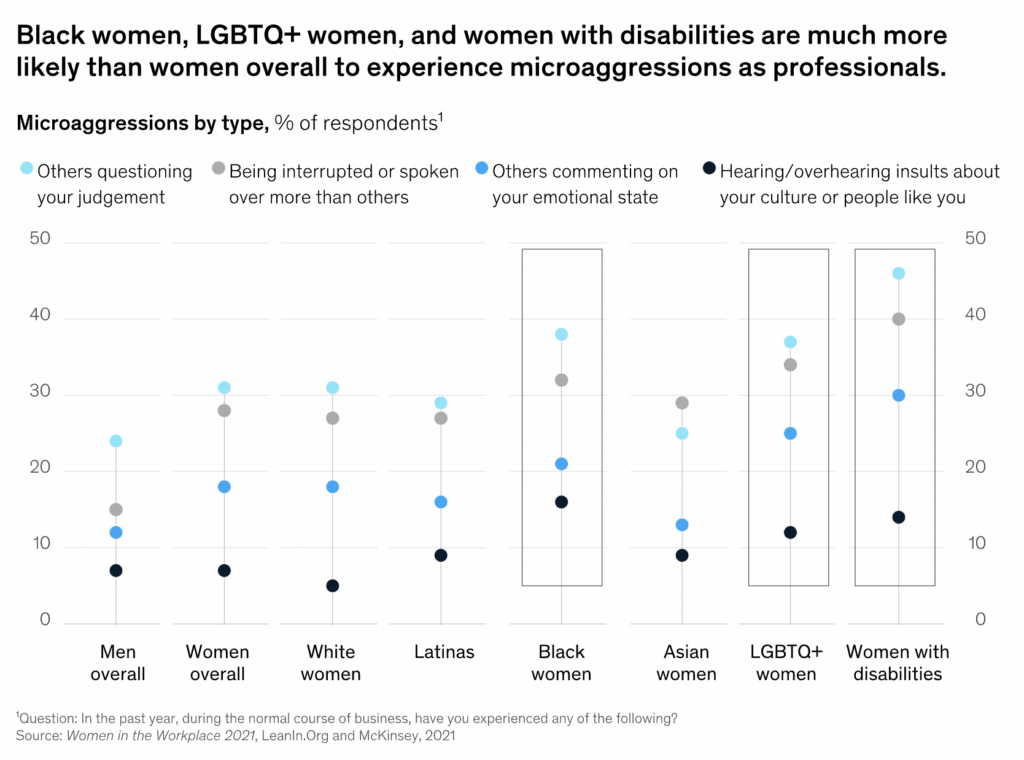
Provide employees a safe way to share their feedback as 71% of employees would be more likely to share experiences and opinions on DEI at their company if they could do so anonymously.
6. Employee resource group (ERG) participation
According to Traliant, 24% of DEI leaders are "somewhat unconfident" that employees feel a sense of belonging, inclusion, and psychological safety.

An Employee Resource Group (ERG) is a platform for employees who share a common identity to meet and support each other and increase their sense of belonging within the organization.
ERG programs empower these groups by offering them organizational and financial support and leadership access.
If you have ERGs in your organization it’s worth evaluating the participation rate in these groups. If people are reluctant to join, it's important to determine why and re-evaluate the inclusion initiatives.
7. Accessibility
Accessibility is a huge part of your DEI initiatives. To ensure all your employees feel included, evaluate whether your workplace is accessible to everyone.
Some questions you can ask to ensure accessibility are:
- Can all employees physically access all parts of the office?
- Do all employees have a comfortable place to use the bathroom?
- Do you offer adequate paternal leave along with maternity leave?
- For employees with disabilities, do you have screen readers and other relevant equipment?
- Do you recognize all types of cultural and religious holidays?
8. Pay Equity
One of the most significant issues in DEI is equal pay for equal work. Let’s have a look at jobs with some of the widest pay gaps in the US.
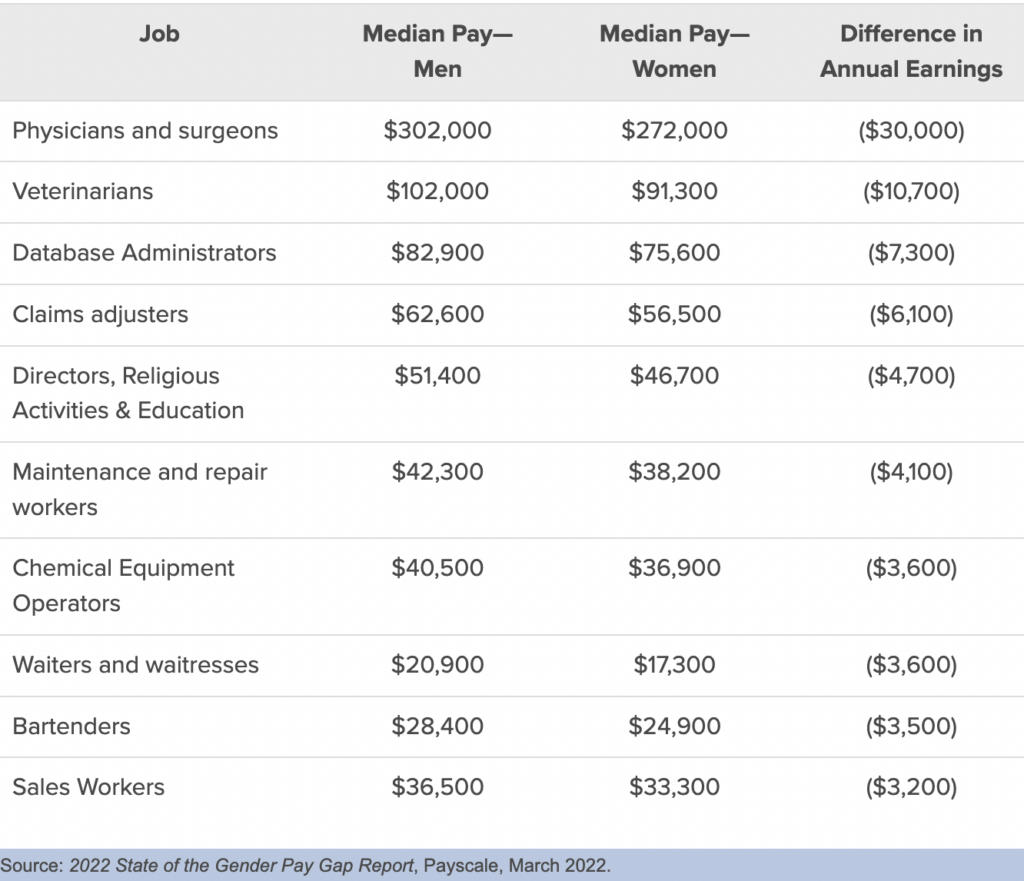
Analyzing pay disparities within your organization will help you recognize potential gaps in your pay practices and design solutions to help them.
A Statista survey showed that 65% of respondents credit DEI initiatives for fair compensation, which shows that DEI efforts greatly impact pay equity.
For help, check out our article on how to conduct a pay equity audit.
Company Representation
To ensure diversity, equity, and inclusion in the entire organization, it's important to track diversity metrics in the public areas of your company.
9. Leadership
Diversity in a company's leadership is crucial to increasing revenue. According to McKinsey, companies at the top for gender diversity in the executive team are 25% more likely to have above-average profitability. At the same time, women of color account for only 4% of C-suite leaders.
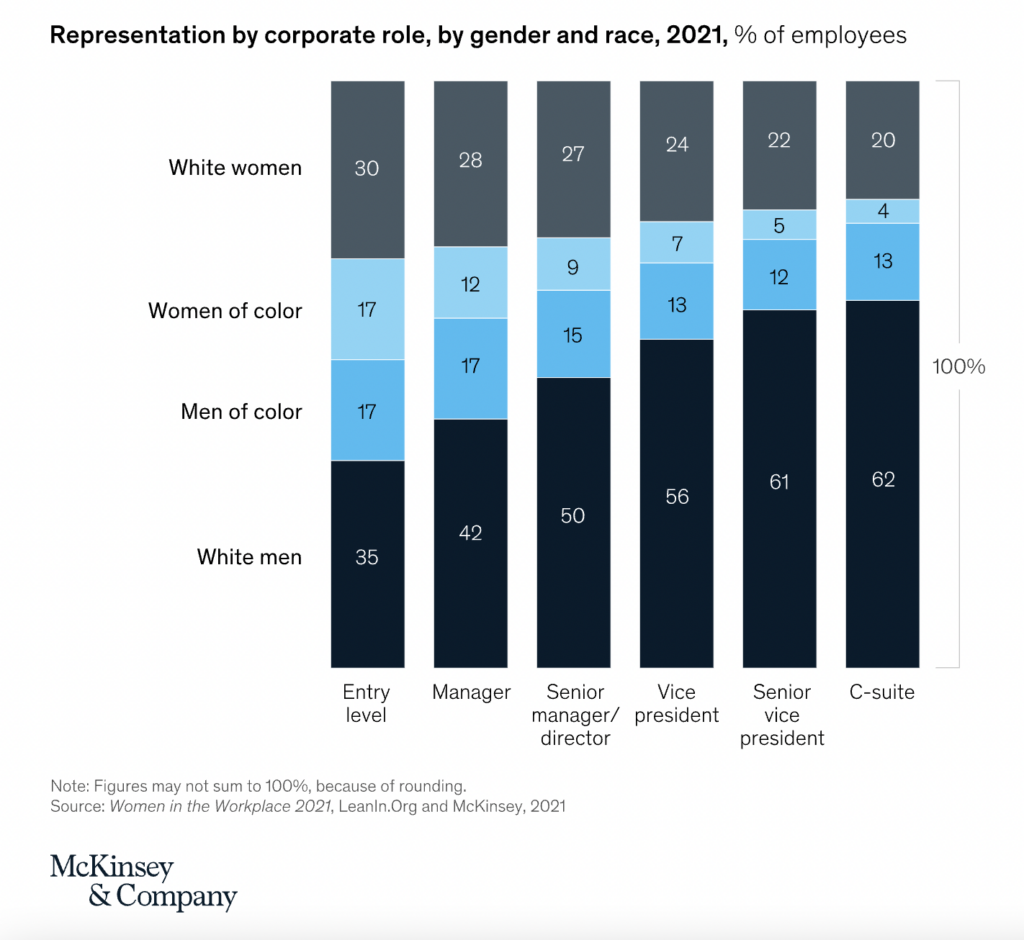
According to Pew Research, 2020 saw an all-time high of 7.4% female CEOs of Fortune 500 companies. While three Asian American women serve as CEOs, no Black or Hispanic women head Fortune 500 companies.
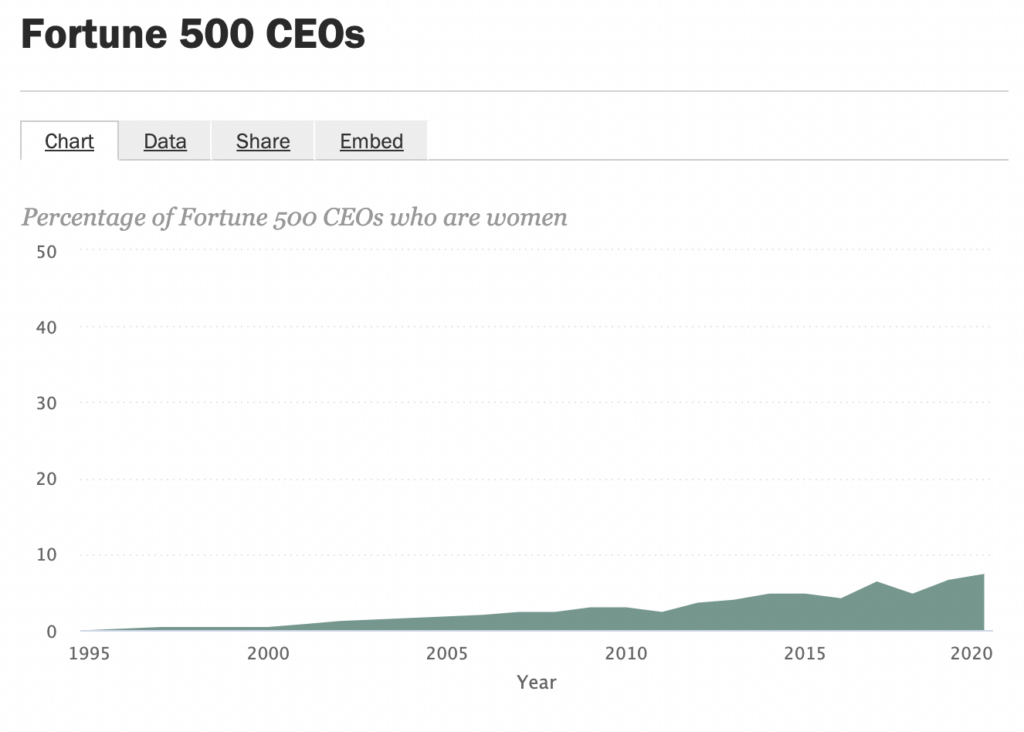
Currently, there’s an all-time high of 10.4% female CEOs of Fortune 500 companies. But this is still low when you consider around 50% of the workforce is female. There are also very few women of color included in that number, with only two black female CEOs.
When addressing diversity in the C-suite, it's not enough to focus on women to address diversity. Is your executive team diverse? What about your board members?
If not, your organization needs to prioritize diversity to create a more inclusive leadership team. To ensure diversity in senior leadership, here are a few questions to ask:
- How many people from diverse backgrounds are moving to leadership positions?
- Is it taking longer for ethnic employees to get promoted?
- Is the career trajectory for non-white employees the same as for white employees?
Apart from diversity, it's equally important to evaluate the leadership commitment and see whether they are dedicated to diversity efforts. Inclusive leaders are the building blocks of an inclusive organization.
Goldman Sachs shared their DEI progress that has helped facilitate 50 diverse placements for private and public companies.
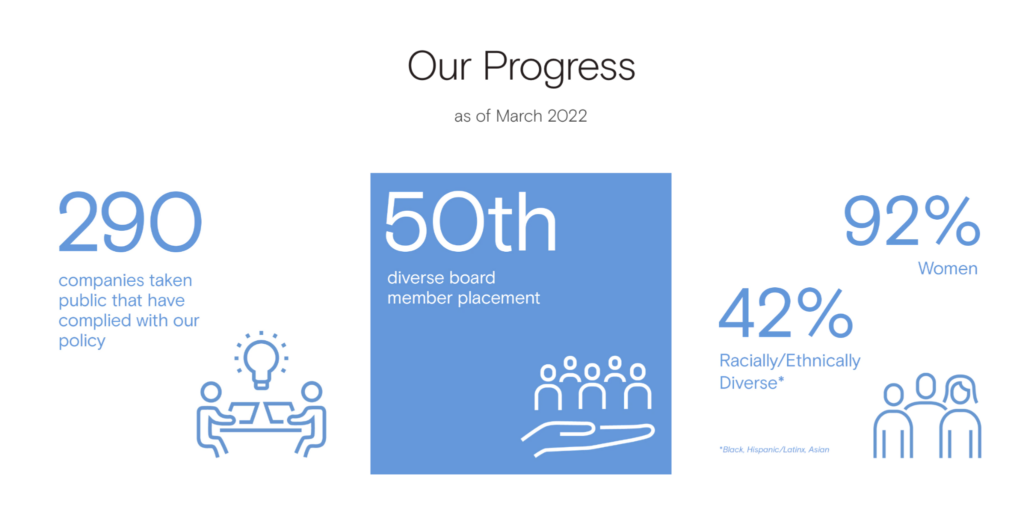
10. Partners and Vendors
This metric might seem a bit uncommon, but it's not enough to look at who your organization hires; it's equally important to evaluate who you collaborate with. It will ensure that the vendors, partners, and other businesses your organization collaborates with aren’t because of any bias.
Some questions to ask include:
- Are you using diverse suppliers for your organization's needs?
- Have you made an effort to give underrepresented businesses a chance at vendor relationships?
- Do you have a diverse range of speakers for webinars or conferences?
- Do you support underrepresented small business owners?
Resources Spent On DEI
While measuring the outcomes of your DEI efforts is important, it's crucial to track and measure your organization's input to these initiatives.
11. Budget allocation
While DEI initiatives are not all about money, fostering a culture that genuinely prioritizes diversity, equity, and inclusion requires funding.
With 34% of employees admitting that DEI programs helped them identify unconscious bias and learn about systematic barriers to equality in the workplace, it's important to have consistent funding for DEI programs and initiatives including EABs and DEI certifications.
12. Mentorship programs
According to McKinsey, 67% of Black employees do not have a sponsor in their organization, even though 87% of companies have a sponsorship program in place.
Evaluating your mentorship programs and measuring how accessible they are for all your employees is a great way to track your DEI efforts.
With mentorship as part of your overall DEI program, organizations create a more inclusive work environment, help employers meet their DEI goals, and increase diverse representation in leadership.
By measuring the total number of hours mentors spend with mentees, you can measure the effectiveness and utility of these programs. Have a look at the mentorship program at Lyft to advance the careers of its Black and Latinx employees.
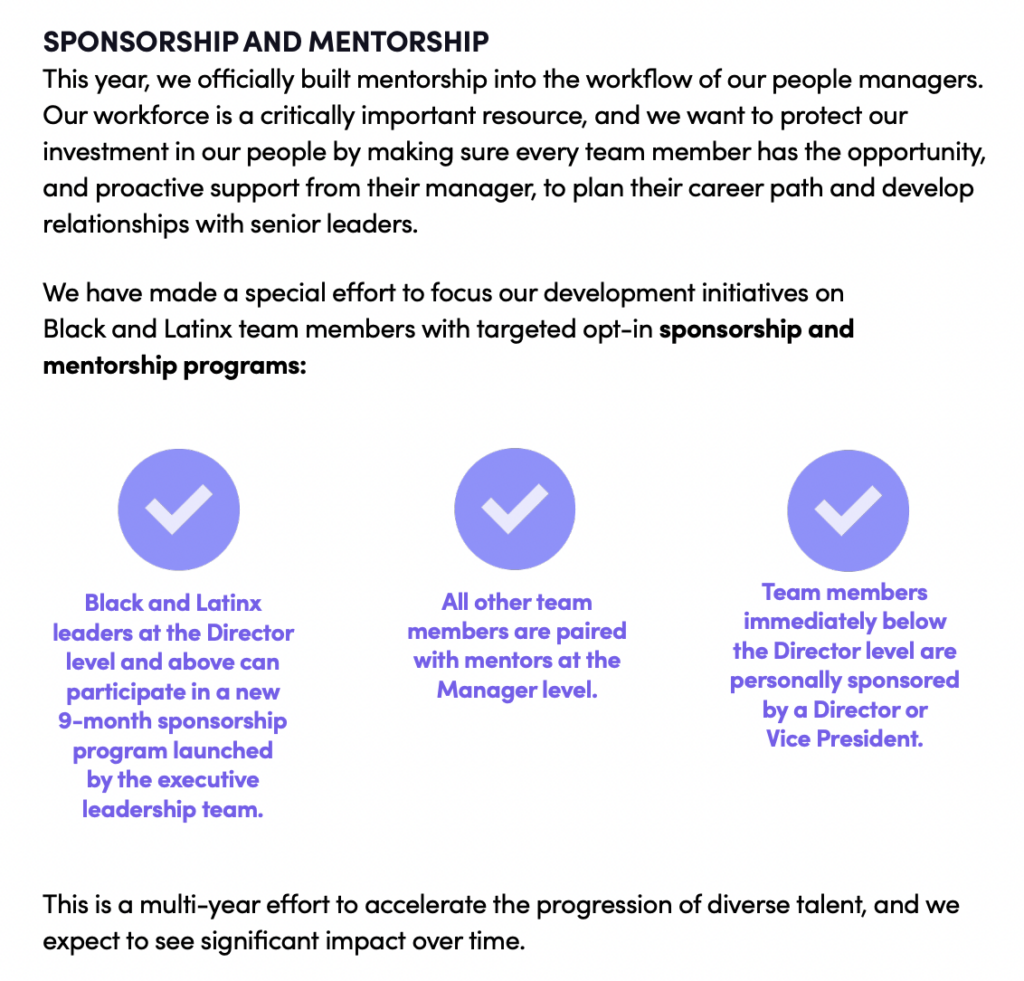
Measure Your DEI Strategy To Drive Real Change!
Put simply, you can't manage what you can't measure. And that's the case with DEI initiatives and efforts.
If you don't know what's working or what employees are responding to, your DEI efforts can quickly go downhill. In the words of Anthony Clay, "DEI is a discipline. It's not a headline. And you have to invest in it like a discipline, or else it will just disappear."
Instead of using the DEI initiatives as mere scaffolds for performative solidarity, focus on providing a safe, inclusive, and comfortable environment for your employees.
Join the People Managing People Community
For further advice on creating more diverse, inclusive and equitable workplaces, join our supportive community of HR and business leaders sharing knowledge and expertise to help you grow in your career and make greater impact in your org.


